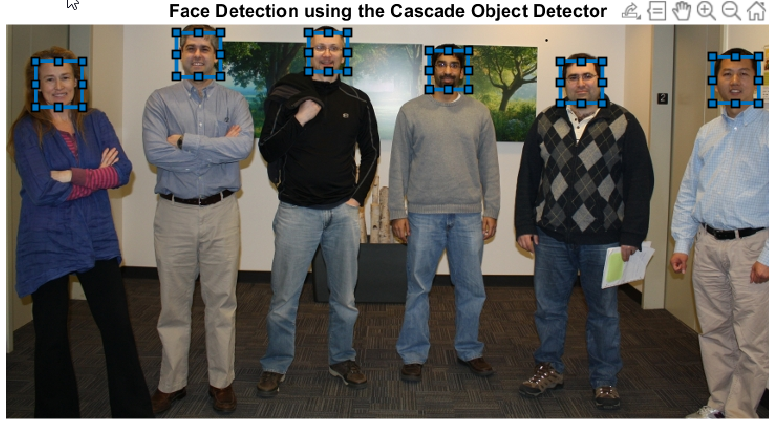Detect and Track Multiple Faces
Avi's pick of the week is Detect and Track Multiple Faces by Dima Lisin.
One of the projects I was working on recently required the detection and tracking of multiple objects (pedestrians in my case) over time in a video stream. While I know how to implement this myself I was hoping someone had some code I could modify for my problem, as I often do I called my friend Dima who is a developer on the Computer Vision System Toolbox team. Dima pointed me to his excellent File Exchange submission that I was able to modify to solve my problem in under a minute.
There are three basic steps required to solve the object detection and tracking problem:
First, let's look at how this is done in Dima's code.
We start by connecting to a webcam using the USB Webcam support package.

The next thing Dima's code does it adds a detection to the tracker object. This object does most of the heavy lifting and decided when to create a new track or if a detection is associated with an existing track. The tracker object in this File Exchange submission manages the new detections and the state of objects being tracked.
Finally, I modified Dima's code to solve by problem simply by replacing the object detector used with a model used to detect pedestrians by changing this code. The detector models to locate faces and pedestrians are both part of the Computer Vision System Toolbox.
- Detect object of interest in current frame
- Match detections to current list of objects the system is tracking
- Update the status of each track, create new tracks, and delete lost tracks
vidObj = webcam;The next step is to create an object that is used to detect faces in input frames, in this case I use vision.CascadeOjectDetector that detects faces by default.
faceDetector = vision.CascadeObjectDetector(); % Finds faces by default
The last object I create is used to "track" all the detected faces.
tracker = MultiObjectTrackerKLT; % We then acquire new frames till we succesully detect the first % object/face. videoPlayer = vision.DeployableVideoPlayer; % Iterate until we have successfully detected a face bboxes = []; while isempty(bboxes) framergb = snapshot(vidObj); frame = rgb2gray(framergb); bboxes = faceDetector.step(frame); endNow lets look at the first detected object or face.
figure; framergb = insertObjectAnnotation(framergb,'Rectangle',bboxes,'Face'); imshow(framergb);title('First Detected Face');

The next thing Dima's code does it adds a detection to the tracker object. This object does most of the heavy lifting and decided when to create a new track or if a detection is associated with an existing track. The tracker object in this File Exchange submission manages the new detections and the state of objects being tracked.
tracker.addDetections(frame, bboxes);After this the detection and tracking code is run in a loop till the video window is closed. Note that the detector is run only once every 10 frames to improve execution performance.
%And loop until the player is closed frameNumber = 0; keepRunning = true; while keepRunning framergb = snapshot(vidObj); frame = rgb2gray(framergb); if mod(frameNumber, 10) == 0 %(Re)detect faces. % % NOTE: face detection is more expensive than imresize; we can % speed up the implementation by reacquiring faces using a % downsampled frame: % bboxes = faceDetector.step(frame); bboxes = 2 * faceDetector.step(imresize(frame, 0.5)); if ~isempty(bboxes) tracker.addDetections(frame, bboxes); end else %Track faces tracker.track(frame); end %Display bounding boxes and tracked points. displayFrame = insertObjectAnnotation(framergb, 'rectangle',... tracker.Bboxes, tracker.BoxIds); displayFrame = insertMarker(displayFrame, tracker.Points); videoPlayer.step(displayFrame); frameNumber = frameNumber + 1; keepRunning = isOpen(videoPlayer); end %Clean up release(videoPlayer);This is what it looks like when I run the loop above.
Finally, I modified Dima's code to solve by problem simply by replacing the object detector used with a model used to detect pedestrians by changing this code. The detector models to locate faces and pedestrians are both part of the Computer Vision System Toolbox.
faceDetector = vision.CascadeObjectDetector(); % Finds faces by default % to this pedestrianDetector = vision.PeopleDetector;If you are working on a project that involves detecting and tracking objects in images and video, I'd highly recommend trying out this pick.
- カテゴリ:
- Picks








コメント
コメントを残すには、ここ をクリックして MathWorks アカウントにサインインするか新しい MathWorks アカウントを作成します。